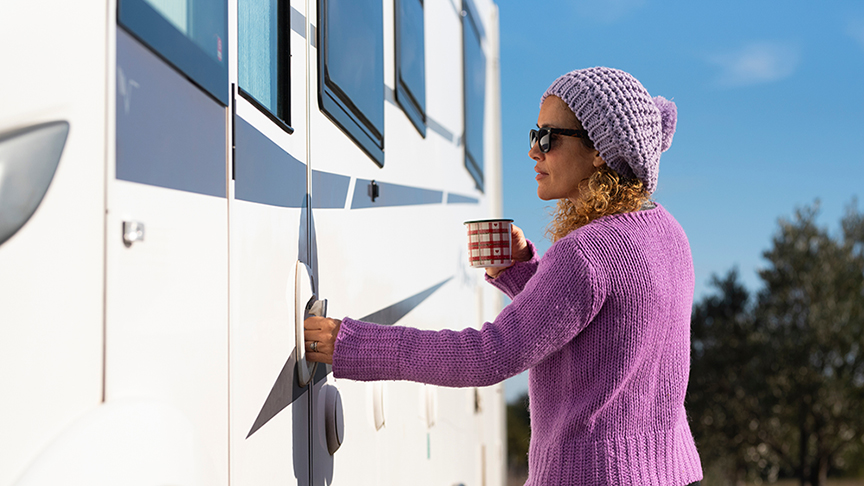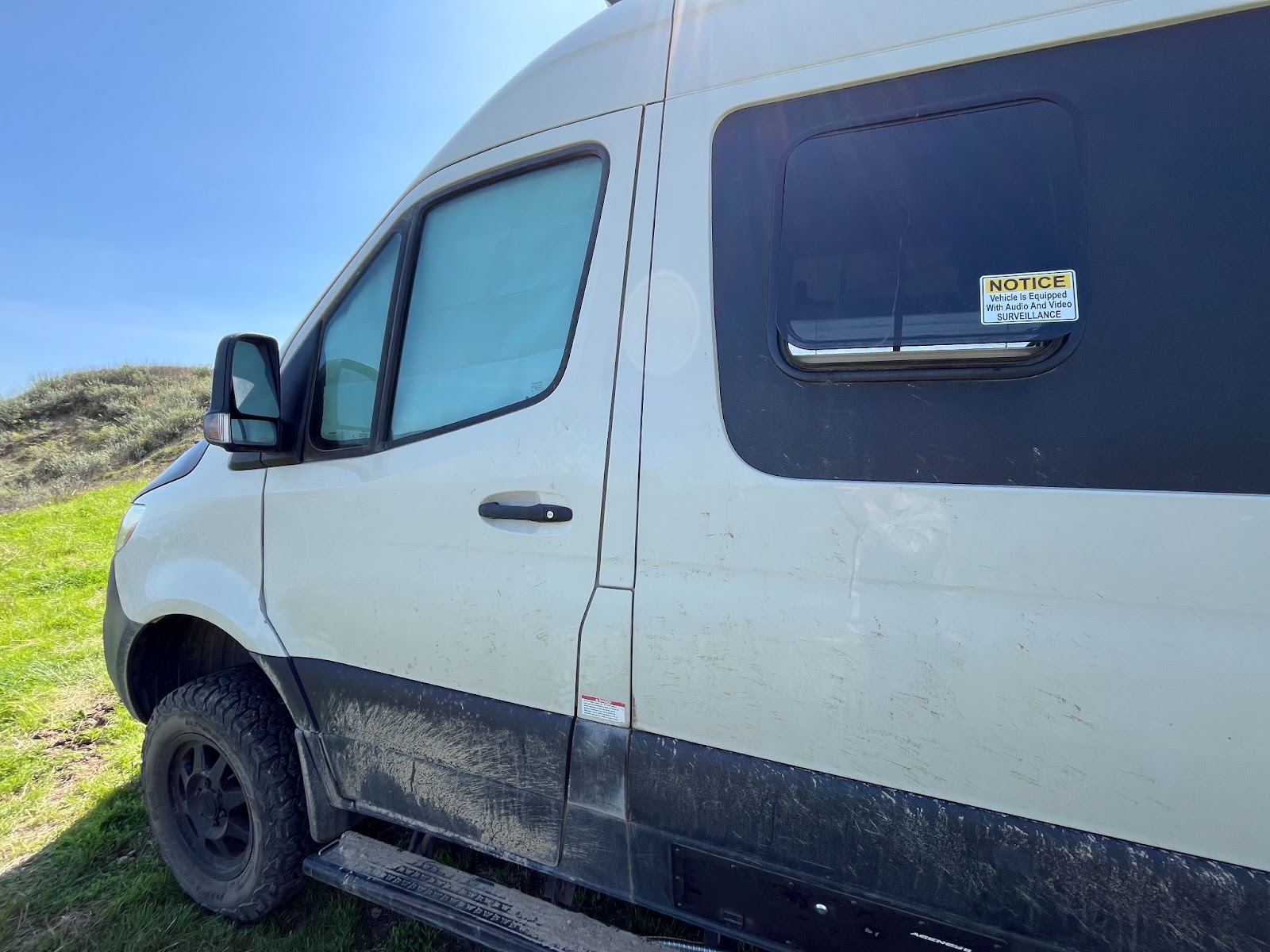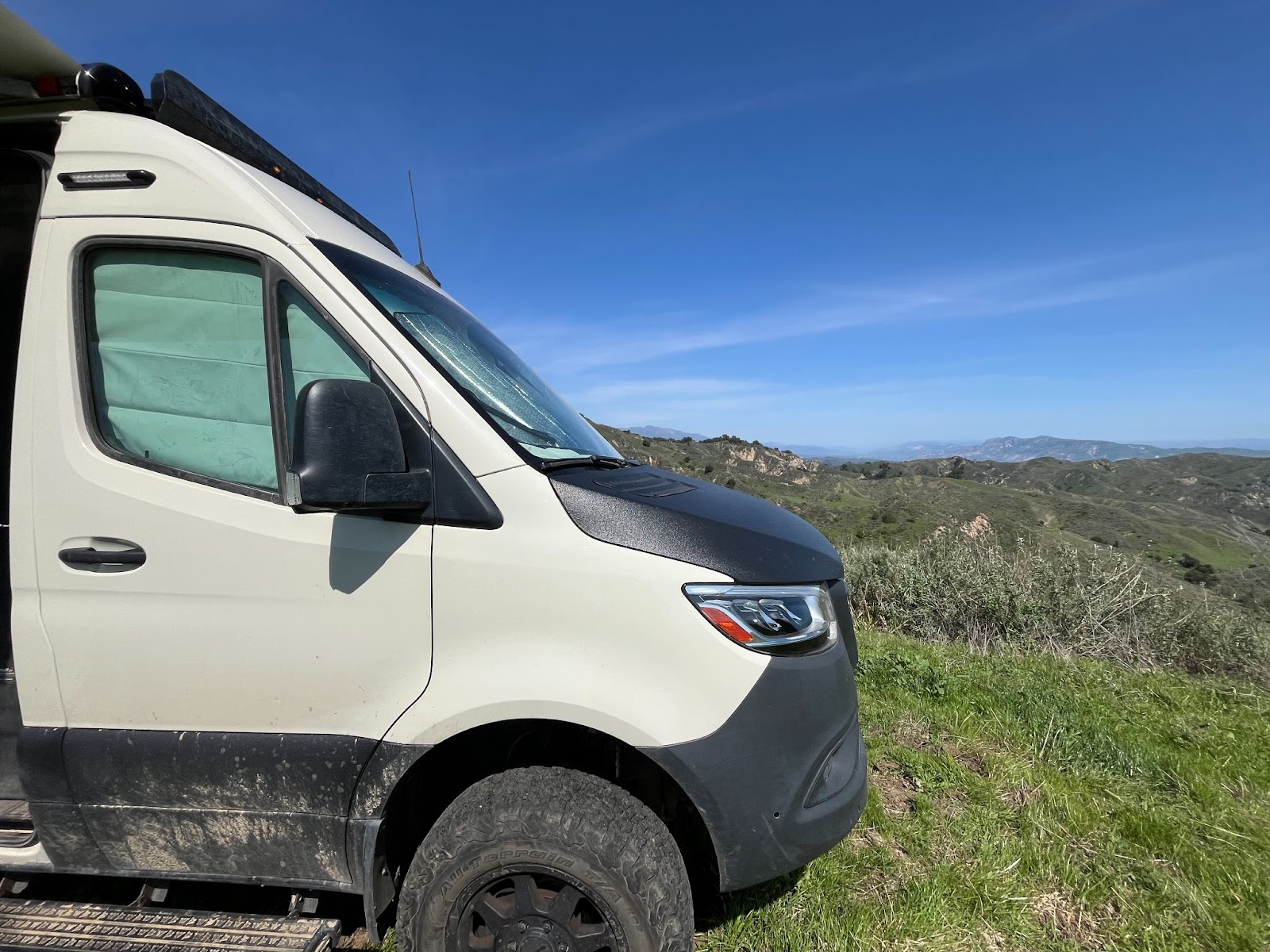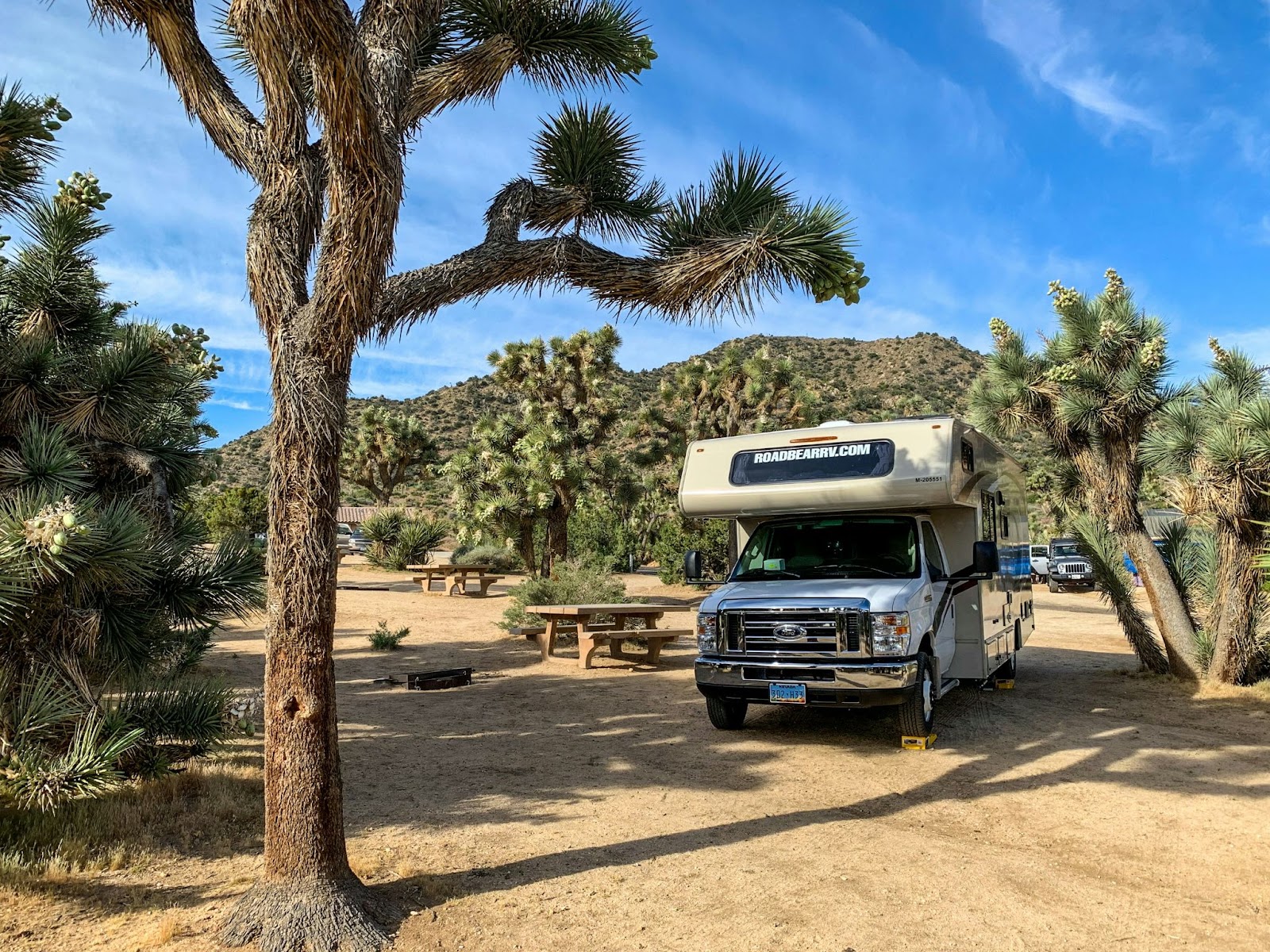
Deep in the desert of Arizona, I had a spooky boondocking experience. I put together this guide to RV security tips so you can stay safe.
We turned off the highway onto a narrow dirt road in the middle of nowhere, Arizona. The sun had set; the sky was fading fast. Half a mile of washboard track later, a Bureau of Land Management sign appeared: Good, at least we were on public land. Still, I felt uneasy pulling into a remote site at dusk with no time to scope it out.
A few rigs were already parked, so we kept going until we found a flat clearing. But three large, zipped-up event tents stood around it. Weird. My husband peeked inside: bins of party supplies, folding chairs, an empty tent with a lone hammer on the ground. Weirder. We decided to stay anyway, not sensing a real threat.
Thirty minutes later, headlights and flashlights cut through our van. A convoy of SUVs rolled up. We left immediately—no harm done, but lesson learned.
Camping is usually safe, and most RVers are good people. Still, odd situations happen. With the freedom of RV life comes the responsibility to keep yourself, your loved ones, and your gear secure, no matter where you park. Here’s how you can.
Experts Who Contributed to This Article:
- Nate and Christian Axxness of ProjectTrek
- Kate Mullen of The Road to Adventure
- Jeff Ketelaars, Co-Founder at Security Guards Only
- Jeremy Gocke, Founder at Entropy Survival
- Colt Fetters, spokesperson at REDARC
This article was written by Amanda Capritto, TravlSync editor and full-time vanlifer of two years.
Key Takeaways:

How to Stay Safe in an RV

Simple tricks, like placing surveillance stickers on your rig, can deter potential criminals from messing with you or your RV. Photo by Amanda Capritto.
Trust Your Intuition
First things first: Trust your gut. Always. My husband and I broke that cardinal rule in the desert, and it didn’t take but a few minutes for my intuition to prove itself right. Never stay in a campsite where something feels off, even if you can’t put your finger on what’s not right.
Arrive at Your Spot Before Dark
Try to get to camp before dark, so you have time to survey the surroundings and take stock of the people and/or wildlife nearby. When you arrive in the dark, you don’t have the opportunity to get ahead of potential threats.
Maintain Emergency Supplies
As Nate and Christian Axxness of ProjectTrek put it, “Don’t be caught without something you really need. Pack emergency items such as a first aid kit, emergency blanket(s), tools, spare tires, extra fuel, paper maps, satellite communicator, etc. You may never use these things, but if you need them, you’ll sure be glad you packed them.”
Jeremy Gocke, founder of Entropy Survival, recommends every RV-dweller and vanlifer keep this list of essentials on hand:
- Water (3+ days supply) and purification tools
- Medical kit with trauma supplies
- Reliable comms (satellite messenger/radio)
- Recovery gear (straps, shovel, traction boards)
- Fire-starting tools & shelter (tarp, bivy)
“These are mission-critical for hydration, injury response, rescue communication, vehicle extraction, and surviving exposure, regardless of season or terrain,” Gocke says.
Read TravlFi’s complete guide to overlanding survival and download our emergency gear checklist.
Have an Engine Failsafe
In addition to survival and vehicle recovery gear, it’s crucial to have a system that can restart your engine if it fails to turn over. “One of the most frustrating (and realistic) emergencies is getting stuck in the middle of nowhere with a dead starter battery,” says Colt Fetters, spokesperson at REDARC. “And it doesn’t matter how many traction boards or winches you’re carrying—if your engine won’t turn over, you’re not going anywhere.”
Fetters recommends a DC-DC charger with solar input, calling it “one of the most underrated pieces of gear you can install.” It gives you safe, reliable charging whether you're driving or parked, and protects both your batteries over time. When paired with a house battery, it keeps your gear running for days without risking your starter battery.
Know Your Whereabouts
“Always know your GPS coordinates in case you need to call 911,” the Axnesses say. “It’s also a good idea to share those coordinates with someone you trust and communicate with often. Lastly, be sure you know where the closest emergency room is.”
Lock Doors and Windows At Night
This goes without saying, but even at remote boondocking sites, lock all entrances to your RV. Even if you’re far, far away from the nearest humans, wildlife could enter your RV if doors are unsecured. Yes, bears are known to open car doors.
Install Automatic Exterior Lighting
Motion-activated lighting is standard practice in traditional residences, so why not on your RV or van? Installing motion-sensor lights around your RV can help deter intruders. These lights will automatically turn on when they detect movement, making it difficult for anyone to approach unnoticed.
Place Surveillance Stickers Around Your Rig
Secret’s out: Even if you don’t have surveillance on your RV, you can still buy stickers that say you do. I have stickers on my van that say, “NOTICE: Vehicle Is Equipped With Audio and Video Surveillance.” While I do have cameras (I use a WOLFBOX rear and front dashcam that runs off of my house battery), stickers alone can deter criminals who are simply opportunists.
Have a Safe and Reliable Internet Setup
One of the most important aspects of staying secure on the road is having a reliable internet connection. Whether you need to check in with loved ones, monitor your surveillance system remotely, or access emergency services, a strong internet connection is essential. Portable hotspots and routers support multiple device connections and allow you to access information and services when you need them most. TravlFi’s unlimited RV internet and range of portable WiFi devices have you covered. Starlink is a good choice for those who frequent areas without cellular service.
How to Prevent RV Theft

Always cover your windows to prevent thieves from peering inside. This can prevent a break-in. Photo by Amanda Capritto.
Install a Security Camera System
Keeping an eye on your surroundings is crucial, especially when you're in unfamiliar territory. A surveillance system with cameras that provide real-time footage can deter potential thieves and give you a sense of security.
Invest in High-Quality Locks
The first line of defense for any RV is a good set of locks. Ensure that all doors, windows, and storage compartments have sturdy, high-quality locks. Consider upgrading to deadbolts or adding additional locking mechanisms for extra security. This includes steering wheel locks and boot locks on wheels to prevent theft of the RV in its entirety.
Put Items Away When Gone
I know, I know. It’s incredibly annoying to pack up all of your stuff when you leave your campsite and unpack it when you return. And the reality is, in most established campgrounds, you don’t need to. Theft of personal effects in that setting is unlikely. But it’s not impossible, and packing up is the only surefire way to prevent it.
Lock Up Valuables
For items that aren’t easily put away, lock them up. A strong U-lock goes a long way for bikes, scooters, grills, and other bulky belongings. Again, this may not be necessary in established campgrounds, especially locations that employ security staff. But it’s always a best practice, and when boondocking, a necessity—you never know when an opportunist might pass by your campsite, however remote.
Close Window Treatments
Don’t tempt passers-by. By putting up your window shades or drawing the curtains, you prevent a potential thief from peering in your RV and seeing something they’ve gotta have. It’s a simple but effective rule to live by: Don’t leave valuables in plain sight.
RV Driving Safety Tips
Conduct a Pre-Trip Safety Check
Keep your RV maintained and serviced regularly, and double-check everything before you go. This includes all fluids, filters, hitch and tow vehicle connections, tire tread and pressure, pullouts/retractables, windshield chips and cracks, wheel lug nuts, and more. You can download TravlFi’s RV pre-trip checklist to ensure you don’t miss anything.
Be Prepared
Kate Mullen of The Road to Adventure says it’s key to have spare parts, fuses, tire kits, etc., ready for an emergency. Additionally, “Keep call numbers handy or programmed in your phone and be prepared to advocate for the level of service you feel is required,” she says. “If you do not have a tow vehicle, consider an e-bike as a back-up or Lyft/Uber car services (depending on availability in the area) that could transport you to a safer location.”
Install a Dash Cam
For on-the-road incidents, a dash cam can save you from he-said-she-said situations and insurance hassles. With a dash cam—ideally front and rear—there’s no speculation, only the truth.
Follow All Traffic Laws and Regulations
This is another point that goes without saying but is always a good reminder. Obey traffic signs, speed limits, and other regulations in the area you are traveling in. This is the best way to not only avoid incidents with other drivers but also to prevent unnecessary damage to your RV from any cause. And be sure to know your vehicle clearance and take alternate routes if necessary.
Give All Non-Driving Duties to the Passenger
When you’re driving, drive. Your passenger can be your DJ, GPS, and snack provider. If you’re traveling solo, get your route and playlist loaded before pulling out of the driveway. Keep a stash of snacks and drinks within arm’s reach or pull over for a break.
FAQs
How to keep my RV from being stolen?
Make it difficult for a thief to steal your RV. Invest in high-quality locks for your doors, windows, wheels, and steering wheel. Try to park in safe areas. Traveling with friends helps, too—there’s safety in numbers.
How do I protect my RV from theft?
Lock up your valuables; lock your doors and windows; close your window shades; install security cameras and motion-sensor lighting; and place stickers warning thefts of surveillance on your rig. These are my top RV security tips as far as preventing theft.
Are RVs safe to live in?
Generally, yes, it is safe to live in an RV. As a full-time RV-er, I would argue that I feel much safer living in my van than I ever did living in a busy city, and even in some suburbs. I tend to boondock, so my greatest threats are typically wildlife. But in campgrounds, there is often some kind of security presence; plus, RVers are some of the kindest people I have ever met. The community is strong and helpful!
What should I do if someone tries to break into my RV?
If you suspect someone is breaking in, stay calm and don’t try to confront them. Lock yourself in a secure area—like the bedroom or bathroom—call 911 or local emergency services, and make noise to draw attention. If you have a panic alarm or horn, use it. Keep your keys, phone, and a flashlight near your bed at night so you can act quickly if something happens.
How do I keep my RV safe when camping off-grid?
When boondocking far from other campers, focus on deterrence and communication. Use motion lights or small battery alarms, park where you can easily drive away if needed, and share your location with someone you trust. A satellite communicator like a Garmin inReach can be a lifeline if you’re out of cell range. Keeping valuables out of sight also helps avoid unwanted attention.
Does RV insurance cover theft or break-ins?
Not always. Some RV insurance policies only cover collision damage, so it’s worth checking if you have coverage for theft, vandalism, or stolen items inside your rig. You can usually add personal property protection for your gear, electronics, and camping equipment. It’s also smart to keep photos or a quick inventory list of your valuables in case you need to file a claim later.
TravlFi Devices for RVing
TravlFi keeps you connected on the road. Not sure which device is best for you? Compare below.


Article By: Amanda Capritto
Amanda Capritto is a fitness and outdoors journalist who travels full-time in a Winnebago camper van. Her work has appeared in national and global outlets like Lonely Planet, Reader's Digest, CleverHiker, CNET, and more.


